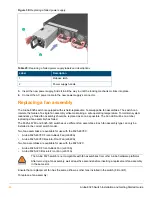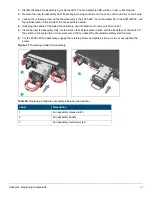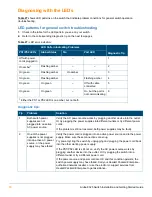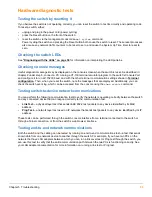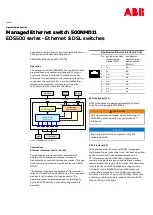
60
Aruba 8325 Switch Installation and Getting Started Guide
with the Category 5e specifications, as described in Addendum 5 to the TIA-568-A standard (ANSI/TIA/EIA-568-A-
5).
Because of the increased speed provided by 1000BASE-T (Gigabit-T), network cable quality is more important
than for either 10BASE-T or 100BASE-TX. Cabling plants being used to carry 1000BASE-T networking must
comply with the IEEE 802.3ab standards. In particular, the cabling must pass tests for Attenuation, Near-End
Crosstalk (NEXT), and Far-End Crosstalk (FEXT). Additionally, unlike the cables for 100BASE-TX, the 1000BASE-
T cables must pass tests for Equal-Level Far-End Crosstalk (ELFEXT) and Return Loss.
When testing your cabling, be sure to include the patch cables that connect the switch and other end devices to the
patch panels on your site. The patch cables are frequently overlooked when testing cable and they must also
comply with the cabling standards.
Note on 10GBASE-T cable requirements
The Category 6 networking cables that work for 1000BASE-T connections may work for 10GBASE-T, as long as
the distance is less than 30m and the cable installation has been tested for compliance to IEEE requirements. But,
for the most robust connections, you should use cabling that complies with the Category 6A or Category 7
specifications, as described in the TIA-568-C (ANSI/TIA-568-C.2) and ISO/IEC 11801 standards. 10GBASE-T is a
sophisticated technology that relies upon high quality cable installations. It is sensitive to Alien Near End Crosstalk
(ANEXT) which can arrive upon the cable due to cables placed in close proximity to the data cables. It is
recommended that cable dressing be done carefully and in compliance with recommendations in the TIA TSB-
155A.
Like 1000BASE-T, 10GBASE-T requires testing of all the crosstalk and return loss parameters described above,
and also ANEXT.
In addition to ANEXT, 10GBASE-T is more sensitive to external electrical noise in the environment. It is
recommended that radio transmitters and other sources of high frequency continuous wave radio frequency be
kept away from LAN cables.
When testing your cabling, be sure to include the patch cables that connect the switch and other end devices to the
patch panels on your site. The patch cables are frequently overlooked when testing cable and they must also
comply with the cabling standards. For 10GBASE-T, Category 6 patch cables are sensitive to movement once link
has been established, and could cause link to drop if moved. Therefore, Hewlett Packard Enterprise recommends
using Category 6A patch cables, or using cable management options to tie down (dress) the Category 6 patch
cables so they cannot move.
For Conducted and Radiated Immunity in accordance with EN55024, the Aruba switch is limited to Performance
Criteria A with shielded cables (CAT6A).
Technology distance specifications
Table 30:
Technology distance specifications
Technology
Supported cable type
Multimode fiber
modal bandwidth
Supported distances
1000BASE-T
1
twisted-pair copper
N/A
up to 100 meters
10GBASE-T
2
twisted-pair copper
N/A
Cat 6A unshielded - up to 100 meters
Cat 6A shielded - up to 100 meters
Cat 7 shielded - up to 100 meters
10GBASE-CR
(Direct Attach)
twinaxial copper
N/A
(various lengths offered)
Содержание 8325 Series
Страница 6: ...6 Aruba 8325 Switch Installation and Getting Started Guide...
Страница 48: ...48 Aruba 8325 Switch Installation and Getting Started Guide...
Страница 58: ...58 Aruba 8325 Switch Installation and Getting Started Guide...
Страница 62: ...62 Aruba 8325 Switch Installation and Getting Started Guide...

